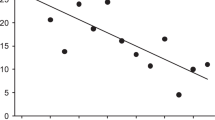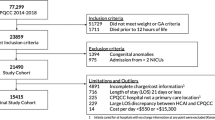Abstract
Increasing numbers of neonatal intensive care units have formed small baby units or small baby teams with the intention to optimize care of extremely premature infants. Considerable time, energy, and resources are required to develop and sustain complex quality improvement constructs, so legitimate questions about effectiveness, unintended consequences, and lost opportunity costs warrant scrutiny. The small baby unit literature is diminutive. Errors of chance, bias, and confounding secondary to insufficient definitions of process and outcome metrics, overlapping quality improvement projects, and limited cost analyses restrict firm conclusions. Well-established quality improvement methodologies such as evidence-based guidelines, standardized variability reduction using measurement-and-adjust techniques, family-integrated focus, and developmentally sensitive care, reliably improve outcomes for all-sized premature infants. There is not compelling published evidence that adding specialized small baby units or designated teams for extremely premature infants further enhances short- or long-term health if robust quality improvement fundamentals are already imbedded within local culture.
This is a preview of subscription content, access via your institution
Access options
Subscribe to this journal
Receive 12 print issues and online access
$259.00 per year
only $21.58 per issue
Buy this article
- Purchase on Springer Link
- Instant access to full article PDF
Prices may be subject to local taxes which are calculated during checkout

Similar content being viewed by others
References
Morris M, Cleary JP, Soliman A. Small baby unit improves quality and outcomes in extremely low birthweight infants. Pediatrics. 2015;136:e1007–e1014.
Nankervis CA, Martin EM, Crane ML, Samson KS, Welty SE, Nelin LD. Implementation of a multidisciplinary guideline-driven approach to the care of the extremely premature infant improved hospital outcomes. Acta Paediatr. 2010;99:188–93.
Lester BM, Salisbury AL, Hawes K, Dansereau LM, Bigsby R, Laptook A, et al. 18-month follow-up of infants cared for in a single-family room neonatal intensive care unit. J Pediatr. 2016;177:84–89.
Vohr B, McGowan E, McKinley L, Tucker R, Keszler L, Alksninis B. Differential effects of the single-family room neonatal intensive care unit on 18-to-24 month Bayley scores of preterm infants. J Pediatr. 2017;185:42–8.
O”Brien K, Robson K, Bracht M, Cruz M, Lui K, Alvaro R, et al. Effectiveness of family integrated care units on infant and parent outcomes: a multicentre, multinational, cluster-randomised controlled trial. Lancet Child Adol Health. 2018;2:245–54.
O’Callaghan N, Dee A, Philip RK. Evidence-based design for neonatal units: a systematic review. Matern Health Neon Perinat. 2019;5:6 https://doi.org/10.1186/s40748-019-0101-0
Erdei C, Inder TE, Dodrill P, Woodward LJ. The growth and development unit: a proposed approach for enhancing infant neurodevelopment and family-centered care in the neonatal intensive care unit. J Perinatol. 2019;39:1684–7.
van Veenendaal NR, Heideman WH, Limpens J, van der Lee JH, van Goudoever JB, van Kempen AA, et al. Hospitalising preterm infants in single family rooms versus open bay units: a systematic review and meta-analysis. Lancet Child Adol Health. 2019;3:147–57.
van Veenendaal NR, van Kempen AA, Franck LS, O’Brien K, Limpens J, van der Lee JH, et al. Hospitalising preterm infants in single family rooms versus open bay units: a systematic review and meta-analysis of impact on parents. E Clin Med. 2020;23:100388.
White RD. Recommended standards for newborn ICU design, 9th edition. J Perinatol. 2020;40:2–4.
Lehtonen L, Lee SK, Kusuda S, Lui K, Norman M, Bassler D, et al. Family rooms in neonatal intensive care units and neonatal outcomes: an international survey and linked cohort study. J Pediatr. 2020;226:112–7.
Hei M, Gao X, Li Y, Gao X, Li Z, Xia S, et al. Family integrated care for preterm infants in China: a cluster randomized controlled trial. J Pediatr. 2021;228:36–43.
Kaempf JW, Morris M, Austin J, Steffen E, Wang L, Dunn M. Sustained quality improvement collaboration and composite morbidity reduction in extremely low gestational age newborns. Acta Paediatr. 2019. https://doi.org/10.1111/apa.14895
Kaempf J, Morris M, Steffen E, Wang L, Dunn M. Continued improvement in morbidity reduction in extremely premature infants. Arch Dis Child FNN. 2020. https://doi.org/10.1136/archdischild-2020-319961
Soghier L, Short BL. The secret sauce: secrets of high performing neonatal intensive care units. Arch Dis Child FNN. 2018. https://doi.org/10.1136/archdischild-2018-314844
Kaempf JW, Wang L, Dunn M. Using a composite morbidity score and cultural survey to explore characteristics of high proficiency neonatal intensive care units. Arch Dis Child FNN. 2018. https://doi.org/10.1136/archdischild-2017-313715
Zeitlin J, Manktelow BN, Piedvache A, Cuttini M, Boyle E, van Heijst A, et al. Use of evidence based practices to improve survival without severe morbidity for very preterm infants: results from the EPICE population based cohort. BMJ. 2016;354:i2976.
Horbar JD, Edwards EM, Greenberg LT, Morrow KA, Soll RF, Buus-Frank ME, et al. Variation in performance of neonatal intensive care units in the United States. JAMA Peds. 2017. https://doi.org/10.1001/jamapediatrics.2016.4396
Lee SK, Shah PS, Singhal N, Aziz K, Synnes A, McMillan D, et al. Association of a quality improvement program with neonatal outcomes in extremely premature infants: a prospective cohort study. CMAJ. 2014;186:E485–E494.
Franck LS, O’Brien K. The evolution of family-centered care: from supporting parent-delivered interventions to a model of family integrated care. Birth Defects Res. 2019. https://doi.org/10.1002/bdr2.1521
Burke S. Systematic review of developmental care interventions in the neonatal intensive care unit since 2006. J Child Health Care. 2018;22:269–86.
Griffiths N, Spence K, Loughran-Fowlds A, Westrup B. Individualised developmental care for babies and parents in the NICU: evidence-based best practice guideline recommendations. Ear Hum Dev. 2019. https://doi.org/10.1016/j.earlhumdev.2019.104840
Rizzolo A, Shah PS, Boucorian I, et al. Cumulative effect of evidence-based practices on outcomes of preterm infants born at <29 weeks gestational age. Am J Obstet Gynecol. 2020;222:181.e1–10.
Twilhaar ES, Wade RM, de Kieviet JF, van Goudoever JB, van Elburg RM, Oosterlaan J. Cognitive outcomes of children born extremely or very preterm since the 1990s and associated risk factors: a meta-analysis and meta-regression. JAMA Peds. 2018. https://doi.org/10.1001/jamapediatrics.2017.5323
Myrhaug HT, Brurberg KG, Hov L, Markestad T. Survival and impairment of extremely premature infants: a meta-analysis. Pediatrics. 2019;143:e20180933.
Lien R. Neurocritical care of premature infants. Biomed J. 2020;43:259–67.
Thurow LC. Learning to say “No”. NEJM. 1984;311:1569–72.
Chassin MR, Loeb JM. High-reliability health care: getting there from here. Milbank Quart. 2013;91:459–90.
Braithwaite J, Herkes J, Ludlow, Testa L, Lamprell G. Association between organisational and workplace cultures, and patient outcomes: systematic review. BMJ Open. 2017;7:e017708.
Berwick DM. The moral determinants of health. JAMA. 2020;324:225–6.
Berlin I. The proper study of mankind. Farrar, Strauss and Giroux. New York, NY 1998.
Shrank WH, Rogstad TL, Parekh N. Waste in the US health care system estimated costs and potential for savings. JAMA. 2019. https://doi.org/10.1001/jama.2019.13978
Beam AL, Fried I, Palmer N, et al. Estimate of healthcare spending for preterm and low-birthweight infants in a commercially insured population: 2008-2016. J Perinatol. 2020;40:1091–9.
Culbertson L, Dukhovny D, Lapcharoensap W. Examining the relationship between cost and quality of care in the neonatal intensive care unit and beyond. Children. 2020. https://doi.org/10.3390/children7110238
Lu D, Ruan B, Lee M, Yilmaz Y, Chan TM. Good practices in harnessing social media for scholarly discourse, knowledge translation, and education. Perspect Med Educ. 2021:23-32.
Funding
Manuscript preparation was supported by Women and Children’s Services, Providence Health System, Portland, OR. Providence Health System had no role in the content of the manuscript.
Author information
Authors and Affiliations
Contributions
JW Kaempf and K Gautham conceived the original manuscript concept. JW Kaempf drafted the initial version. JW Kaempf and K Gautham reviewed subsequent revisions, and both attest to the veracity of the final manuscript content.
Corresponding author
Ethics declarations
Conflict of interest
The authors declare no competing interests.
Additional information
Publisher’s note Springer Nature remains neutral with regard to jurisdictional claims in published maps and institutional affiliations.
Special Thanks: Alison Leiataua, Providence Heart Institute, Portland, OR, assisted expertly preparing the manuscript figure.
Rights and permissions
About this article
Cite this article
Kaempf, J.W., Gautham, K. Do small baby units improve extremely premature infant outcomes?. J Perinatol 42, 281–285 (2022). https://doi.org/10.1038/s41372-021-01076-9
Received:
Revised:
Accepted:
Published:
Issue Date:
DOI: https://doi.org/10.1038/s41372-021-01076-9



